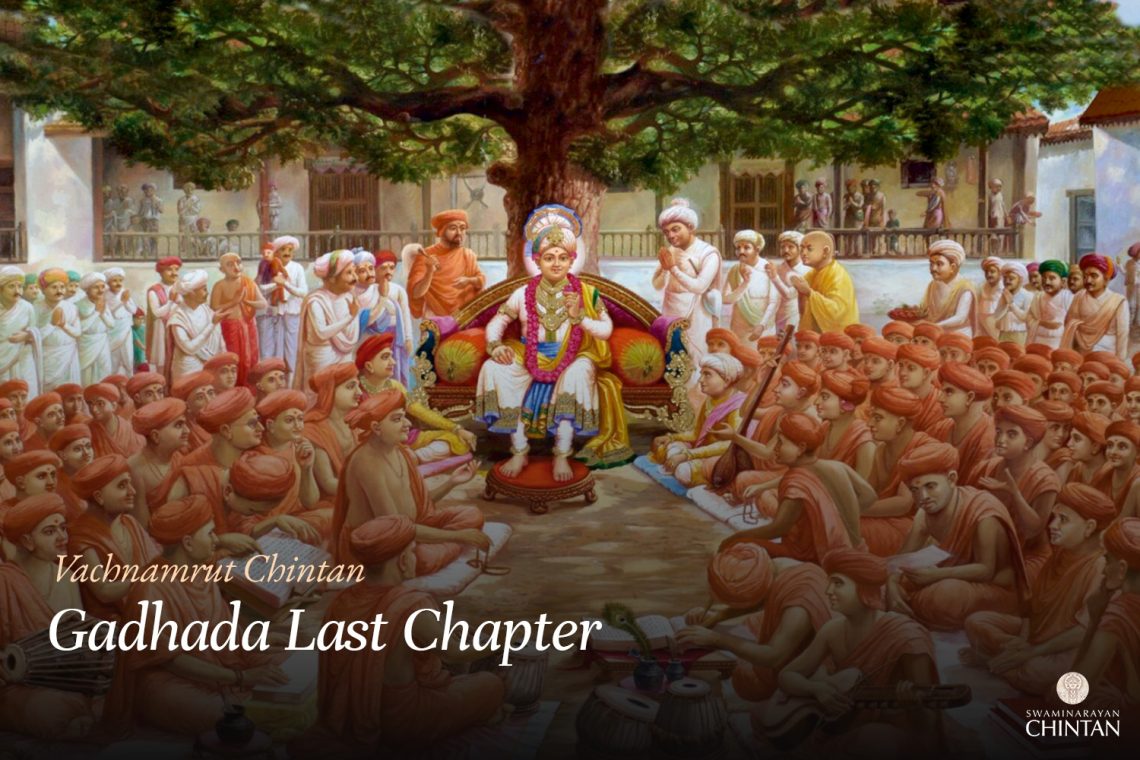Central Insights:
- Faith in the form of Bhagwan and renunciation of six harmful traits.
Key Points:
- The form of Bhagwan is distinct from the forms created by Maya (illusion).
- The form of Bhagwan residing in Akshardham (divine abode) and the manifest form on Earth are identical without the slightest difference.
- A person afflicted with the six harmful traits—greed, etc.—can never be happy, either in this life or after death.
Explanation:
In the initial part of this Vachanamrut, Maharaj explains swaroopnishtha (faith in the divine form). Understanding who the manifest Shreeji Maharaj is and His greatness leads to swaroopnishtha. Maharaj has subtly revealed His identity in this Vachanamrut.
Maharaj states, “We have arrived at a conclusion based on the Shastras such as Sankhya and others.” Faith should be grounded in the Shastras (scriptures) and not in one’s imagination. Maharaj emphasizes the authority of the scriptures. He declares that the forms produced by Maya are illusory and false. Bhagwan may appear human-like but is divine and Sachchidanand (possessing existence, consciousness, and bliss). His muktas (redeemed souls) and devotees are also divine. Out of compassion, Bhagwan manifests in human form on Earth, visible to all, and becomes the cherished deity of devotees. There is no distinction between the form of Bhagwan in Akshardham and His earthly form. He is the cause of all causes, the origin of all incarnations, and worthy of being worshiped with absolute devotion.
Maharaj rarely proclaims His supremacy directly, but here He explicitly clarifies it. Swaroopnishtha implies understanding. A devotee must understand who Shreeji Maharaj is. Without this understanding, even if one has direct association with Him, they cannot fully appreciate His greatness. Therefore, recognizing His divine glory is essential for true swaroopnishtha. In this Vachanamrut, Maharaj offers a direct revelation of His supreme and divine form.
Secondly, a devotee needs to maintain a life of purity. A devotee’s life should be free from the faults prohibited by the Shastras. Only then can one experience the bliss of Bhagwan’s form. Otherwise, even if Bhagwan is physically present and one claims to understand His supremacy, the six harmful traits mentioned in this Vachanamrut will prevent the experience of bliss. Maharaj states that those afflicted with these traits can never be happy, neither while living nor after death. These traits perpetuate suffering across lifetimes.
The first of these is greed for wealth. Maharaj identifies greed as a source of misery. Greed stems from one’s mindset rather than the mere possession of wealth. Wealth by itself is not harmful; instead, it is the attachment to it. For instance, kings like Janak and Ambarish possessed immense wealth but remained detached and spiritually elevated. Similarly, many wealthy devotees during Maharaj’s time were param muktas (liberated souls). Greed is defined as an inability to use wealth appropriately, even when necessary for spiritual or moral purposes, and hoarding wealth without need. A person with no wealth may still be greedy, while someone with vast wealth may not be. Greed originates in one’s attitude towards wealth and obstructs happiness both in life and after death. Therefore, one should renounce greed and adopt detachment.
The second trait is lustful desires for women. Just as wealth can obstruct liberation when one is attached to it, attachment to women (or men) similarly hinders spiritual progress. It is not that women are inherently harmful, but the mental bond and emotional attachment between individuals create obstacles and lead to suffering.
The third is indulgence in sensory pleasures, such as an attachment to taste (ras). The faults lie not in the physical objects themselves but in the mind’s attachment to them. Physical objects serve merely as mediums through which these faults manifest and grow. If these faults are absent in the mind, the objects lose their harmful influence. Thus, one must develop detachment from sensory objects.
The fourth is affection for wicked individuals (kusang). The fifth is undue attachment to relatives. These six traits prevent happiness both in life and after death. Not only do they lead to rebirth, but wherever one is reborn, these traits persist, continuing to cause misery. Maharaj explains that those who desire happiness must renounce these traits. They should associate their lives with a Sant (saint) who is steadfast in Bhagwan’s commands and free from these faults. Furthermore, one must stay away from worldly attachments and sensory temptations to permanently eliminate suffering.
This guidance offers a direct path to eternal joy.
Glossary
| Swaroopnishtha – Steadfastness in God’s form Firm faith and devotion to Bhagwan’s divine personality and form, upheld even during challenges. |
| Sachchidanand – Existence, Consciousness, and Bliss |
| Muktas – Liberated souls residing in the divine abode of God Souls that have attained liberation and are free from the cycle of birth and death. |
| Maya – Illusion The material energy that entangles the Jeev in worldly existence and distracts from Bhagwan. |
| Kamna – Desire or craving Refers especially to sensual desires or worldly cravings. |
| Ras – Attachment to taste or sensory pleasure |
| Kusang – Evil Association Association with individuals or ideologies that destroy faith in Bhagwan and devotion. |
| Vairagya – Detachment From Everything Except God |
| Gyan – Knowledge Knowledge of the self (Atma), God, and distinction from the body. |
| Bhakti – Devotion |
| Dharma – Moral integrity Righteous living in accordance with divine will. |
| Chaturdha Mukti – Four types of liberation Salokya, Sarupya, Samipya, and Sayujya; states of liberation associated with God. |

